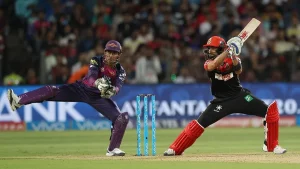Introduction In cricket, every player has an important role, but none quite as unique and demanding as the wicket keeper. Standing quietly behind the stumps, the wicket keeper is often called the “master behind the stumps.” This player is the team’s last line of defense and a key part of every game. Wicket keeping is
Introduction
In cricket, every player has an important role, but none quite as unique and demanding as the wicket keeper. Standing quietly behind the stumps, the wicket keeper is often called the “master behind the stumps.” This player is the team’s last line of defense and a key part of every game. Wicket keeping is more than just catching the ball it is an art that requires sharp reflexes, strong focus, and quick thinking. Whether it’s catching tricky edges, making lightning-fast stumpings, or guiding the bowlers, wicket keepers make a huge difference in cricket. This article explores the fascinating world of wicket keeping, the skills it takes, and the masters who have made this role legendary.
What is Wicket Keeping?
Wicket keeping is a specialized position in cricket where a player stands behind the batsman’s wicket (the three wooden stumps). Their job is to catch the ball if the batsman misses it, stop runs by catching edges, and quickly remove the bails to get batsmen out, especially through stumpings.
Unlike other players, wicket keepers need to stay alert every ball because they can change the game in a split second. They work closely with bowlers and fielders to help control the game’s flow and put pressure on the batting side.
The Skills That Make a Great Wicket Keeper
Wicket keeping might look easy from the outside, but it demands a special set of skills. Here are some of the most important:
- Sharp Reflexes: A wicket keeper must react in the blink of an eye. Balls can come at high speeds or bounce unpredictably, so quick hands and eyes are essential.
- Strong Concentration: Even if a wicket keeper doesn’t touch the ball for several deliveries, they must stay focused. A moment’s lapse can cost the team a key wicket.
- Agility and Flexibility: Squatting behind the stumps for hours requires strong legs and good flexibility. Wicket keepers must move fast and bend low to catch or stop the ball.
- Good Hand-Eye Coordination: Catching fast-moving balls, especially edges that just skim the bat, requires excellent coordination between the eyes and hands.
- Stumping and Throwing Accuracy: To get a batsman out by stumping, a keeper must remove the bails quickly and accurately. They also need strong, precise throws to run batsmen out.
- Communication Skills: Wicket keepers often guide bowlers and fielders during the game. They watch the batsman closely and can give important advice to the team.
Why Wicket Keeping is Important

Image by: Yandex.com
The wicket keeper is often called the backbone of the team’s fielding side. Here’s why this role is so important:
- Catching Edges: Many wickets happen when a batsman nicks the ball, sending it just wide of the bat. The keeper’s job is to catch these edges cleanly to dismiss the batsman.
- Stopping Byes: When a ball passes the batsman without being hit, the wicket keeper tries to stop it from going to the boundary. Saving these runs can make a big difference in tight games.
- Making Stumpings: A quick and skilled keeper can catch batsmen out of their crease and stump them, which is a very effective way to take wickets.
- Supporting Bowlers: Good wicket keepers encourage bowlers and help set fields. They are involved in the team’s strategy and often help bowlers stay focused.
- Creating Pressure: Constantly moving and appealing, keepers can put psychological pressure on batsmen, leading to mistakes.
Famous Masters Behind the Stumps
Over the years, cricket has seen some wicket keepers become legends because of their skill and impact on the game. Here are a few:
- Adam Gilchrist (Australia): Known for his aggressive batting and quick hands, Gilchrist revolutionized the role by being both a fearless batsman and a brilliant keeper.
- Mark Boucher (South Africa): Famous for his lightning-fast stumpings and safe hands, Boucher is one of the highest wicket-takers in cricket history.
- MS Dhoni (India): Dhoni’s calmness, sharp mind, and accurate throws have made him one of the best keepers and captains in modern cricket.
- Kumar Sangakkara (Sri Lanka): Besides his great batting, Sangakkara was an excellent keeper, known for his skill and smooth glove work.
- Alan Knott (England): Knott’s consistency and incredible reflexes made him a trusted wicket keeper for England in the 1970s.
These players showed that being a wicket keeper means being both tough and smart. Their quick reactions and clever game reading helped their teams win many matches.
Training to Become a Great Wicket Keeper
Becoming a master behind the stumps requires hours of practice and dedication. Here’s what training usually involves:
- Catching Drills: Practicing catching balls of different speeds and angles helps improve reflexes.
- Footwork Practice: Quick and balanced foot movements help keepers move fast to reach the ball.
- Squatting Exercises: Keeping muscles strong and flexible helps wicket keepers maintain their stance for long periods.
- Reaction Time Drills: Using special tools or coaches to throw balls unexpectedly helps develop lightning-fast responses.
- Game Awareness Training: Watching batsmen carefully, learning their habits, and understanding bowler strategies improve a keeper’s decision-making.
Good wicket keepers combine physical fitness with strong mental skills. They must stay calm under pressure and always be ready for the next ball.
The Challenges of Wicket Keeping
Despite its importance, wicket keeping is one of the toughest jobs in cricket. Here are some challenges keepers face:
- Long Hours in Tough Conditions: Keepers often squat for many hours in the sun, rain, or cold, which can be very tiring.
- High Pressure: One mistake can cost the team a wicket or many runs. Keepers must handle this pressure well.
- Injury Risk:Balls can hit keepers at high speeds, especially if edges fly quickly or pitches are bouncy.
- Need for Consistency: Keepers must perform well every ball and every game. There is little room for error.
Because of these challenges, wicket keepers are highly respected players who contribute both physically and mentally to their teams.
Conclusion
Wicket keeping is a special art in cricket that combines speed, skill, and sharp thinking. Masters behind the stumps are not just catchers—they are leaders, strategists, and vital players who make big differences in every match. From catching fast edges to making quick stumpings and supporting bowlers, their role is key to a team’s success. The best wicket keepers train hard, stay focused, and bring energy and confidence to their teams. For anyone who loves cricket, understanding the art of wicket keeping adds a deeper appreciation for this exciting and demanding position.
Whether you’re a player dreaming of standing behind the stumps or a fan watching the game, the skill and dedication of wicket keepers make cricket even more thrilling to watch.
Read Also: Best wicket keeper in India
















